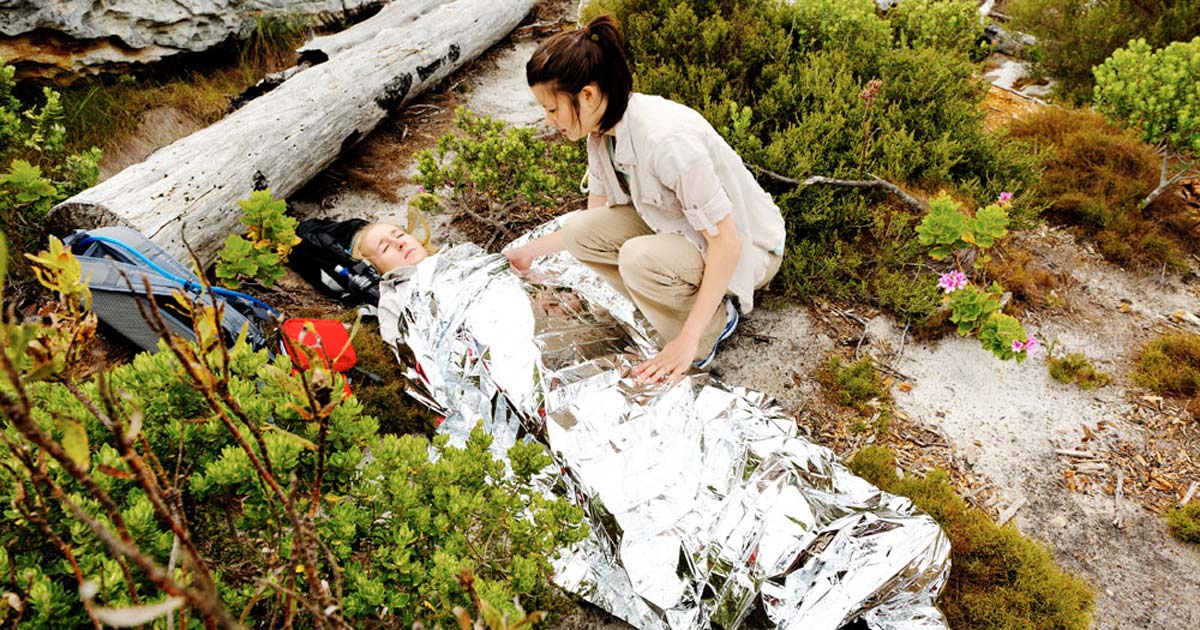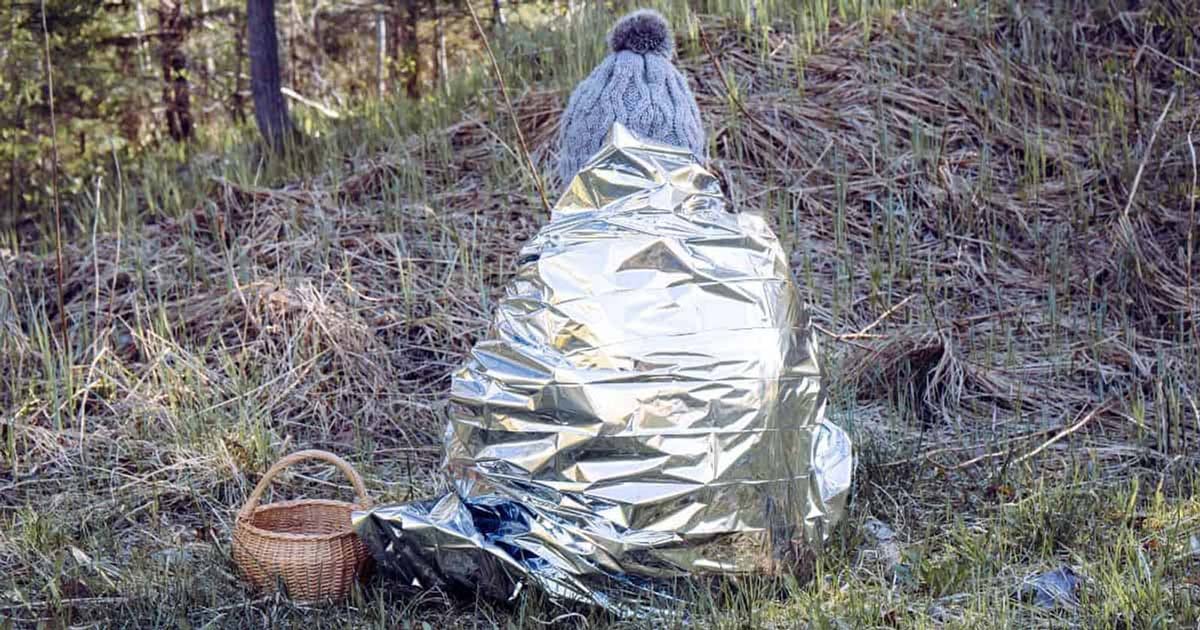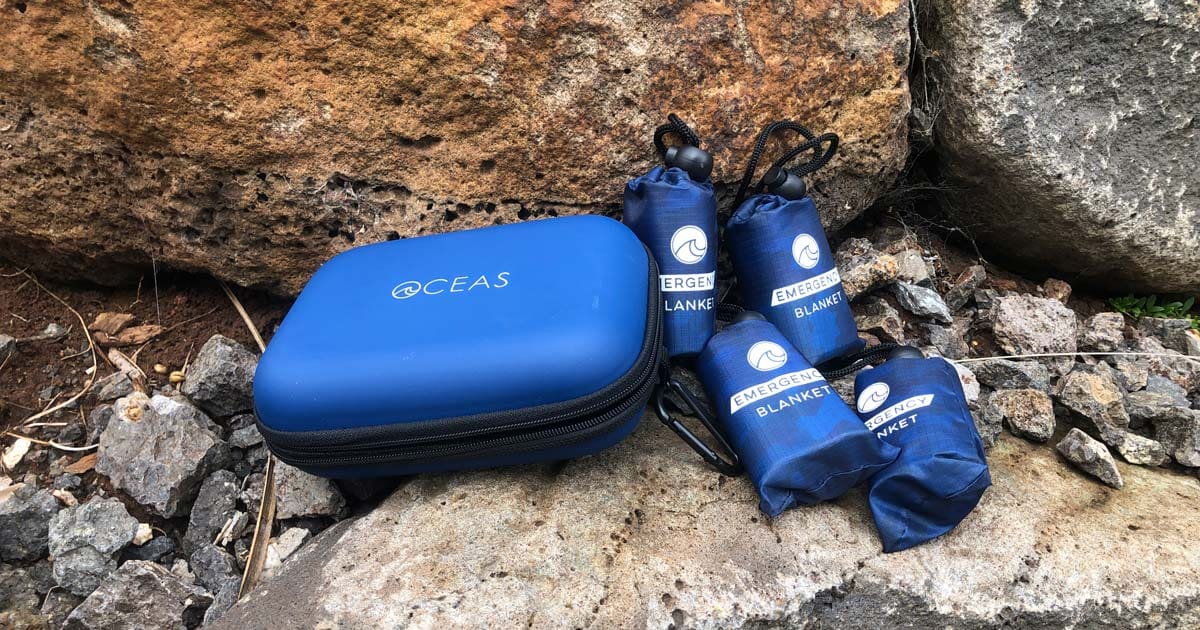As outdoor adventurers and emergency preparedness enthusiasts, we all understand the importance of staying warm and protected in various situations. Whether it’s camping in the wilderness, surviving extreme weather conditions, or dealing with unforeseen emergencies, having the right gear is crucial. One such versatile and effective tool in your arsenal is a space blanket, also known as an emergency blanket or a Mylar blanket. If you have no idea what a space blanket is, how it works, and its many practical uses, read on for some useful tips.
What is a space blanket?

A space blanket is a lightweight, compact, and highly reflective sheet made of Mylar or similar materials. It is designed to provide insulation, reflect and retain body heat, and protect against the elements. Originally developed by NASA in the 1960’s for use in space missions, space blankets have since found their way into various fields, including outdoor recreation, emergency preparedness, and survival situations.
How does a space blanket work?
The unique properties of a space blanket are what make it effective in keeping you warm and protected. The Mylar material used in space blankets is a thin, metallic film that is coated with a layer of polyester or plastic. This metallic coating reflects up to 90% of your body heat back towards you, helping to retain warmth and prevent hypothermia. Additionally, the Mylar material is waterproof and windproof, providing a barrier against rain, snow, wind, and moisture. The lightweight and compact nature of space blankets also make them easy to carry in your backpack, emergency kit, or glove compartment, making them a practical choice for various situations.

Practical uses of a space blanket when hiking
Space blankets can be extremely useful when hiking, as they provide lightweight and compact solutions for emergency situations in the great outdoors. Here are some practical uses for a space blanket while hiking:
- Emergency shelter: If you get lost, injured, or encounter unexpected weather changes during a hike, a space blanket can be used as an emergency shelter to protect yourself from the elements. It can be used as a makeshift tent or tarp to provide a barrier against wind, rain, snow, or sun.
- Heat Retention: Space blankets are designed to reflect and retain body heat. If you find yourself in a cold environment during a hike, you can wrap yourself in a space blanket to help prevent hypothermia and stay warm while awaiting rescue or until you can safely continue your hike.
- Signaling for rescue: The reflective surface of a space blanket can be used to attract attention and signal for rescue. You can use it to catch sunlight or create flashes with a flashlight to increase your visibility to search and rescue teams or other hikers.
- Ground cover: Space blankets can be used as a ground cover to provide insulation and protection against moisture or cold when camping or resting during a hike. They can help to keep you dry and warm by creating a barrier between you and the damp ground.
- Windbreak: Space blankets can be used as a windbreak to provide a sheltered area for cooking, resting, or setting up camp. By creating a barrier against the wind, they can help to make your camping experience more comfortable and safe.
- First aid: Space blankets can be used in first aid situations during a hike. They can be used to wrap around injured or hypothermic individuals to help stabilise body temperature and prevent further heat loss or shock.
- Gear protection: Space blankets can be used to protect your gear from the elements. They can be used as a cover for your backpack, tent, or other gear to keep them dry during rain or snow, or to protect them from dirt, dust, or debris.
- Sun protection: Space blankets can also be used as a makeshift sunshade or reflector to protect yourself from the sun’s harmful rays during hot and sunny hikes. They can be set up as a canopy or draped over a tree to provide shade and help prevent sunburn or heat exhaustion.
- Trail marking: Space blankets can be used as markers to help you find your way back or signal your location to others. You can tie strips of space blanket to trees or rocks to mark the trail or create an emergency signaling device.
- Fire reflector: Using a space blanket as a fire reflector can help increase the warmth of your shelter or camping area by reflecting the heat towards you. However, always exercise caution when dealing with fire and be mindful of fire safety practices to prevent accidents or bushfires. If you need to use a space blanket as a fire reflector, it should be positioned at a safe distance from the fire, as described in the previous response, without coming into direct contact with the flames or embers.
A space blanket is a versatile and essential tool for outdoor enthusiasts, adventurers, and emergency preparedness. Its lightweight, compact, and highly reflective properties make it an effective tool for retaining body heat, protecting against the elements, and providing emergency shelter. Whether you’re camping, hiking, traveling, or preparing for unforeseen emergencies, a space blanket should be a part of your gear. So, stay warm, cozy, and well-prepared with a space blanket in your hiking kit.
Tips for using a space blanket for body warmth
Remember to keep the reflective side of the space blanket facing towards your body to maximise its heat-reflecting properties. It’s also important to keep in mind that while a space blanket can provide temporary warmth in emergency situations, it is not a substitute for proper insulation and shelter, and you should seek appropriate shelter as soon as possible for long-term survival.
- Using next to your skin: It is not recommended to put a space blanket directly next to your skin. The reflective side of a space blanket is designed to reflect heat and is made of a metallic material that may feel uncomfortable and cold against your skin. Placing it directly against your skin can also cause condensation to build up, leading to dampness and reduced effectiveness in retaining heat.
- Insulation or warmth: When using a space blanket for insulation or warmth, it is typically used as an outer layer or barrier to help trap heat and reflect it back towards your body. The best way to use a space blanket for warmth is to wrap it around your body over your clothing or other insulating layers, leaving a layer of air between the blanket and your skin. This can help create a barrier that traps your body heat and provides insulation.
- Covering your head: Covering your head with a space blanket can help retain body heat in cold weather or emergency situations, as the head is a significant source of heat loss. However, it’s important to exercise caution and consider your specific circumstances before covering your head with a space blanket. If you decide to cover your head with a space blanket, make sure to leave enough space for ventilation, avoid covering your face or nose, and be mindful of your comfort and safety. It’s also essential to monitor your body temperature and adjust accordingly to prevent overheating or hypothermia. Here are some factors to consider:
- Weather conditions: If you are in a cold or windy environment, covering your head with a space blanket can help retain body heat and provide insulation. However, if you are in a hot or humid environment, covering your head with a space blanket may cause overheating and discomfort.
- Ventilation: Proper ventilation is crucial for breathing, especially when covering your head. Make sure to leave enough space for fresh air to circulate, and avoid covering your face or nose to ensure unobstructed breathing.
- Comfort: Covering your head with a space blanket may feel confining and uncomfortable for extended periods. It’s important to find a balance between staying warm and maintaining comfort to prevent overheating, sweating, or feeling claustrophobic.
- Safety: If you are in a situation where you need to be alert and aware of your surroundings, covering your head with a space blanket may hinder your ability to hear and see, which could compromise your safety.
- Adjust for comfort: Once the space blanket is wrapped around your body, adjust it for comfort, making sure it fits snugly and covers as much of your body as possible to retain heat effectively.
- Add a source of heat. If you are hypothermic, your body won’t have heat for the Mylar blanket to reflect. You’ll need another source of heat. Put something like a heated rock or a flask with hot water next to you.

Are all space blankets made from mylar
Not all space blankets are made from mylar. Mylar is a brand name for a type of polyester film that is often used as a reflective material in space blankets, but there are other materials that can be used as well. Space blankets, also known as emergency blankets or thermal blankets, are lightweight, compact, and highly reflective blankets that are designed to help retain body heat and provide insulation in emergency situations or outdoor activities.
In addition to mylar, space blankets can also be made from other reflective materials such as aluminum foil, polyethylene, or other types of polyester films. These materials are chosen for their ability to reflect heat and provide insulation by trapping and retaining the body’s heat.
The reflective nature of space blankets helps to reduce heat loss by reflecting the body’s radiant heat back towards the body, which can be helpful in preventing hypothermia or maintaining warmth in cold or emergency situations. However, the specific materials used in a space blanket may vary depending on the manufacturer and the intended use of the blanket. It’s always important to read and follow the manufacturer’s instructions for the proper use of a space blanket to ensure its effectiveness in a given situation.
Are space blankets expensive?
Space blankets are generally affordable and cost-effective. The price of a space blanket can vary depending on the brand, size, and features, but in general, they are relatively inexpensive. Basic, standard-sized space blankets can be found for as low as a few dollars, while larger or more specialised space blankets with additional features may cost a bit more. However, considering the potential life-saving benefits and multiple uses of a space blanket in various situations, they are often considered a worthwhile investment.
It’s important to note that while space blankets are affordable, their durability may vary. Some space blankets are designed for one-time use, while others are reusable and more durable. It’s always a good idea to check the product specifications and read reviews to ensure that you’re getting a space blanket that meets your needs in terms of quality, durability, and price.
Ultimately, the cost of a space blanket is a small price to pay for the peace of mind and protection it can provide in emergency situations or during outdoor adventures. When it comes to safety and preparedness, investing in a reliable space blanket is a smart decision.
What should I consider when buying one?
When buying a space blanket, there are several factors to consider to ensure that you choose a high-quality and effective product for your needs. Here are some things to look for when buying a space blanket:
- Material: Space blankets can be made from different materials, such as mylar, aluminum foil, polyethylene, or other types of polyester films. Look for a space blanket made from durable, tear-resistant, and waterproof materials that are designed to effectively reflect and retain heat.
- Size and weight: Consider the size and weight of the space blanket, as this can affect its portability and ease of use. Space blankets are typically lightweight and compact, making them easy to carry in your backpack, emergency kit, or pocket. Choose a size that is suitable for your intended use, such as a larger size for wrapping around your body or a smaller size for carrying in your pocket.
- Reflectivity: The reflective nature of a space blanket is what helps to retain heat and provide insulation. Look for a space blanket with a high level of reflectivity, as this will enhance its ability to reflect radiant heat and keep you warm in cold or emergency situations.
- Durability: Consider the durability of the space blanket, as it may need to withstand rough handling or outdoor conditions. Look for a space blanket with reinforced edges, sturdy construction, and tear-resistant materials to ensure that it can withstand wear and tear.
- Brand reputation and reviews: Research the brand reputation and read customer reviews to get an idea of the overall quality and performance of the space blanket. Look for feedback on its effectiveness in retaining heat, durability, and ease of use to make an informed decision.
- Additional features: Some space blankets may come with additional features, such as grommets, attachment loops, or integrated shelter designs, which can provide added versatility and functionality in different survival or emergency situations. Consider if these features are important to you and your intended use.
- Price: Compare prices of different space blankets to find one that fits within your budget while still meeting your quality and performance requirements.
By considering these factors, you can choose a space blanket that is durable, reflective, and suitable for your specific needs in emergency situations, outdoor activities, or other situations where warmth and insulation are important. Always read and follow the manufacturer’s instructions for proper use and care of the space blanket to ensure its effectiveness.
Should I carry a space blanket on my hikes?
Carrying a space blanket while hiking or engaging in outdoor activities can be a wise decision as it can provide a lightweight and compact source of insulation in case of emergencies. Space blankets are designed to retain body heat and reflect heat back towards the body, making them useful in preventing hypothermia or providing warmth in cold or unexpected situations. However, whether you should always carry a space blanket while hiking depends on various factors, including the specific circumstances of your hike, the climate and terrain of your hiking location, your level of experience and preparedness, and the duration and remoteness of your hike.
Here are some considerations to keep in mind:
- Climate and terrain: If you are hiking in a cold or remote location where the weather conditions can change rapidly, carrying a space blanket can provide an added layer of protection against cold, wind, rain, or snow. Similarly, if you are hiking in a location with extreme temperatures, such as in deserts or high altitudes, a space blanket can help protect against heat loss or heat exposure.
- Duration and remoteness of the hike: If you are embarking on a short, well-traveled hike in mild weather conditions and close proximity to civilization, the need for a space blanket may be lower compared to a long, remote hike where you may be exposed to harsh weather or limited access to help.
- Preparedness and experience: Your level of preparedness and experience as a hiker can also impact the need for carrying a space blanket. If you are an experienced hiker who is well-prepared with appropriate clothing, gear, and emergency supplies, the need for a space blanket may be reduced. However, for less experienced hikers or those who may be more vulnerable to weather changes, carrying a space blanket can be a valuable safety measure.
- Personal preference: Some hikers (like me) may prefer to carry a space blanket as part of their standard emergency kit, while others may opt for alternative insulation or emergency gear. It ultimately depends on your personal preference, comfort level, and risk tolerance.
Carrying a space blanket while hiking can be a prudent precautionary measure, especially in remote or changing weather conditions. It’s important to assess the specific circumstances of your hike, consider the potential risks, and make an informed decision based on your level of preparedness, experience, and personal preferences. Additionally, always familiarise yourself with the proper use and limitations of a space blanket, and follow manufacturer’s instructions for optimal effectiveness.
I always carry a space blanked on my hikes. They are a small lightweight item that one day may just save your life. I have used mine often. Not for me but for other hikers who where underprepared.






A key resource in our Australian designed Survival Aid Kit (SAK)
Survival Storehouse Pty Ltd might have to check yours out and field test it.
Trail Hiking Australia Absolutely – hit us up and i’ll send you a kit 👍
Survival Storehouse Pty Ltd just checking out your website. Heaps of excellent gear. Might have to remind my kids Father’s Day is coming up
Trail Hiking Australia We will be sending out a father’s day discount code email this weekend so make sure you join our list 👍
Absolutely essential. Tiny. Buy one, stuff it down the bottom of your sack, forget about it till you need it.
A small and lightweight bit of gear with SO many uses!